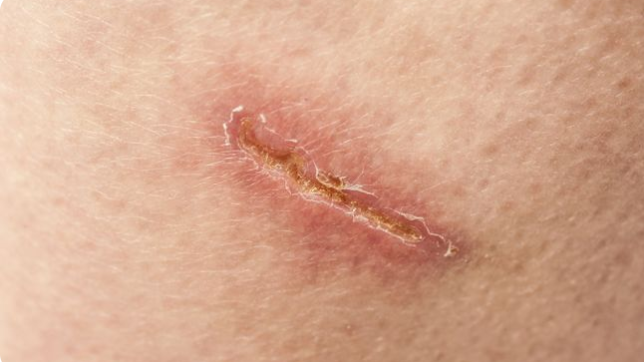Whether your wound is traumatic or surgical, its healing is a very complex process. Each stage of wound healing serves a different purpose, and wound scabs are designed to seal damage in body tissue to prevent infection, dehydration, or other collateral damage. This is a natural dynamic process that goes through different stages. The smooth functioning of each of them plays a crucial role in the formation of scars. This article will introduce you to the wound healing mechanism, so please come and see it with me.
1. What is the process of wound healing?
The basic process of wound healing is the acute inflammation stage→cell proliferation stage→scar formation stage→regeneration of the epidermis and other tissues.
2.What are the stages of wound healing?
There are three types of wound healing: primary healing, secondary healing, and tertiary healing.
① Primary healing is seen in wounds with few tissue defects, neat wound margins, no infection, and close wound closure after gluing or suture, such as surgical incisions. Such wounds contain only a small amount of blood clots, the inflammatory response is mild, and re-epidermal regeneration covers the wound within 24 to 48 hours. Granulation tissue can grow from the edge of the wound on the third day and quickly fill the wound. Collagen fibers are formed in 5 to 6 days (the stitches can be removed at this time), and it heals completely in about 2 to 3 weeks, leaving a linear scar. . Primary healing time is short and scarring is less.
②Secondary healing is seen in wounds with large tissue defects, uneven wound margins, open folds, unable to align neatly, or accompanied by infection. The healing of this kind of wound is different from primary healing in the following ways: ①Due to a large amount of necrotic tissue, or due to infection, local tissue degeneration and necrosis continue to be caused, and the inflammatory reaction is obvious. Regeneration cannot begin until the infection is controlled and the necrotic tissue is removed. ②The wound is large, the wound shrinks obviously, and a large amount of granulation tissue grows from the bottom and edge of the wound to fill the wound. ③ The healing time is longer, and the scar formed is larger.
③ Tertiary healing is delayed initial closure. The blood, exudate, and necrotic material on the wound surface dried to form a dark brown hard scab, and the above-mentioned healing process was carried out under the scab. After epithelial regeneration is complete, the crust falls off. Healing under a scab usually takes longer than without a scab, so epidermal regeneration must first dissolve the scab before it can grow forward. Because the scab is dry, it is not conducive to bacterial growth, so it has a certain protective effect on the wound. But if there is a lot of exudate under the scab, especially if there is a bacterial infection, you need to change the dressing!
3.How to speed up wound healing?
Wound healing takes time, but there are many ways to support wound healing. Functional dressings are recommended, which can speed up wound healing while avoiding scarring. Recommended functional dressing products manufactured by Longterm Medical:
① Hydrocolloid dressing: It is suitable for superficial wounds and can directly contact the wounds, providing a slightly acidic airtight space for the wounds that are conducive to wound healing. The dressing surface also has a waterproof function, which can reduce the invasion of foreign microorganisms, prevent wound infection, facilitate epithelial tissue crawling, and accelerate wound healing.
②Silicone foam dressing: It is suitable for wounds with a lot of exudates. Unlike traditional gauze, after the dressing absorbs liquid, the surface layer has a porous structure with low surface tension, and the silicone layer does not adhere to the wound surface.can reduce pain, easy to operate.
③Silver lon dressing: It is a local wound dressing containing silver. The silver in its dressings can be released into the wound and provide an antibacterial effect. Promotes granulation tissue growth, dissolves necrotic tissue, and absorbs exudate, it can be used as foam dressing, hydrocolloid, barrier layer, and carbon cloth dressing.
④Silicone scar dressing: The main mechanism of silicone scar dressing to reduce scars is that high-purity medical silicone components inhibit the proliferation of fibroblasts and capillaries, thereby preventing the fading of scar color. Silicone scar gel has scar-improving properties due to the hydration of the scar and the hydration provides better collagen tissue during the healing phase. It smoothes, softens, and smoothes scars, relieves itching, and reduces scar-related discoloration.
For more information on Innomed® dressing, refer to the previous articles. If you have customized needs, you are welcome to contact us; we will serve you wholeheartedly.
At Longterm Medical, we transform this data by innovating and developing products that make life easier for those who need loving care.
Editor: kiki Jia
Date: October 10, 2022

 English
English عربى
عربى Español
Español русский
русский 中文简体
中文简体








